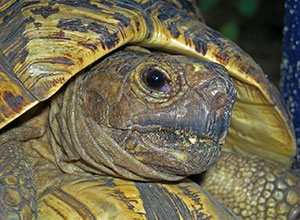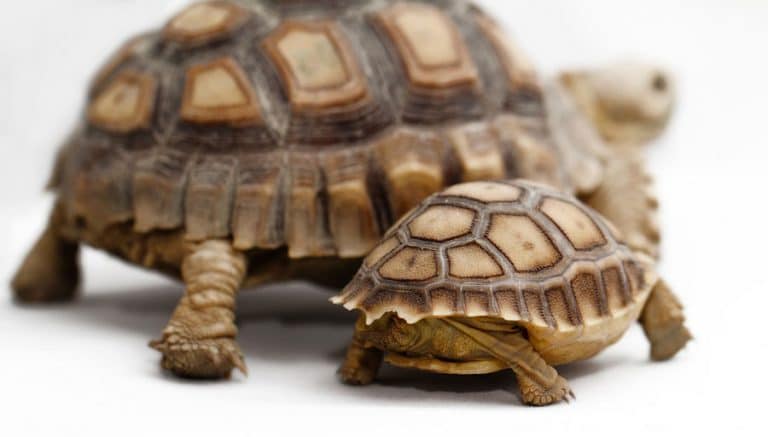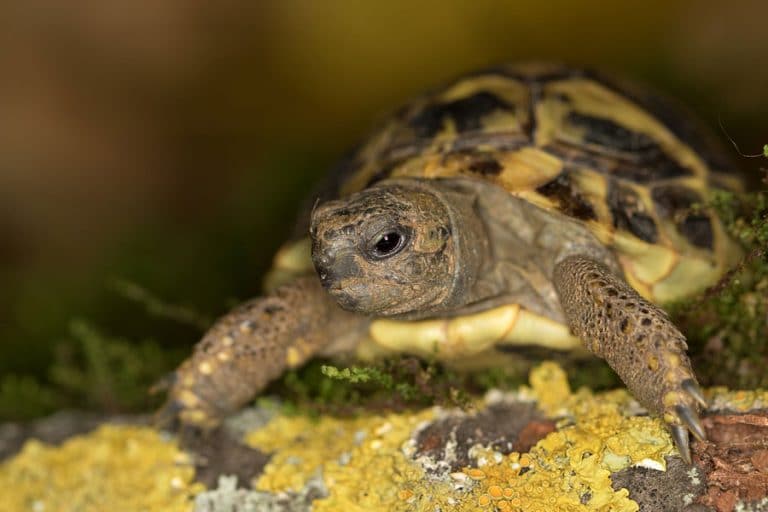Pet Tortoise
You might have seen many people keeping dogs and cats as their pets. What about keeping a pet tortoise? It will be a different experience, full of fun, keeping them as a pet. If you love to do things differently then try a tortoise as your pet this time.
Tortoises do make interesting pets. Their size and food habits can offer a challenge. All tortoises require quite a range of food, even though dietary needs vary depending on the species. The fact is that all species need variety in diet. You have to pay attention to the quantity of roughage and phosphorous-calcium content. Some tortoise species are voracious eaters. Some of the tortoise species are rather large. You have to build for them enclosures of sufficient size, naturally outdoors.
These pets are ideal for areas with favorable climates. You have to consider the temperature of the areas where the tortoises hail from and that of the area where you live. You may have to bring them indoors at nights and during cold weather. With very large Tortoises, provision of indoor housing can pose a real challenge. Some tortoises do hibernate. They need ideal conditions and it can be a stressful affair for the pet and the owner. Tortoises have long life spans. They may live for 50 to 100 years, or more. This means that you have to prepare to provide care for a lifetime. There is always the chance that your pet might outlive you.
Some Important Points to Consider Before Getting a Pet Tortoise

Different Types of Tortoises
For a pet, you can choose from a variety of tortoises, but you will have to consider their specific habitat requirement. You need to do proper research before you arrive at the perfect pet for you from among the several species of tortoises. An Egyptian tortoise or a Pancake tortoise can make good pets, but you would do well to consider data about them before you confirm your choice. While selecting your pet tortoise, you must assess your experience to handle them and also how much time you can spend to take care of them properly.
Getting the Right Tortoise
It is better to get a tortoise bred in captivity. This is not easy in the case of many species. To arrange for the capture and shipping of the pets could be quite a task. This also causes stress for the reptiles and make them prone to diseases. You could get tortoises from rescue homes in some places. If you already have tortoises, you should ensure that the new entrant is free from parasites. It would be better to quarantine them for a while. Some tortoise species are very aggressive. Fights may happen if you keep two males in a small enclosures. This could end in serious eye and leg injuries.
Choosing a Particular Species
It is better to choose the tortoise, keeping in mind its diet, housing and habitat needs. The adult sizes of different species can vary remarkably. Their dietary, light and temperature needs are entirely different. Some tortoises hibernate while others do not. You can find very good pet care sheets on the net that can provide details of the care required.
Tortoises are “creatures” and need to obtain heat from an external source in order to move around and function normally. In the wild, they would get this from the sun. In captivity it is up to you to provide an artificial heat source likes a special reptile lamp which you can suspend over the basking area in the enclosure. The heat in this particular area needs to get up to as high as 95 degrees F, and if this is inadequate your pet may become ill. Tortoises need heat to enable enzymes to work efficiently to break down their food and if this is not sufficient, it will inevitably lead to a number of illnesses related to a dietary deficiency.
Consider Their Size

Planning to keep a tortoise for a pet is an interesting thought, but you must always keep in mind how big they will grow. Do not misinterpret the size of the tortoise from its appearance in the pet store as many of the smaller ones may be young and even the larger specimen that you see could represent the mediocre size of prospective larger growths. Remember that most tortoises attain a large size. Consequently a large enclosure is always imperative for the your pet tortoise, and you would do well to create outdoor enclosures for them. You will, of course, need an indoor pen to protect the tortoises against the harsh winter weather, when they cannot stay outdoors.
Home For Your Tortoise?
Tortoise pet care entails consideration of how they prefer to live. They do not like to be exhibits all the time. You have to provide hideouts for them. If the vivarium you provide is of glass, you must take care to cover three sides. You should also provide enough material for the tortoises to burrow inside the enclosure. A wooden enclosure should be strong enough to ensure that the pets do not escape. Internal features near the enclosure can be a problem since they might climb over and escape, especially during mating season.
How to care for your tortoise begins with its housing needs. It is beneficial to keep your tortoise outdoors as these reptiles need fresh air and natural light to be in the best of health. A secure large pen is the best option with a box for the tortoise to shelter from the sun or to retire to at night. As large a pen as you can manage is best, vegetated with non-poisonous plants and a tortoise proof enclosure. They can climb very well and will burrow at alarming speed, so bear this in mind. The idea of a slow coach is a bit of a myth as tortoises can be quite speedy when they choose to be.
Test your pen out on a hot day when your tortoise will be very active and see if it can escape. Free access to a covered area like a greenhouse or poly tunnel would be perfect, but failing this, a small dog kennel type housing would suffice containing hay bedding for comfort. During bad weather, particularly in winter, when sunlight is low, a well-lit inside area is beneficial and you can consider a UVB light.
You may have to provide a larger area than you visualize for most tortoises to make sure that the enclosure is large enough for their free movement inside it with provision for burrowing when they want to hide. Sine the tortoises are cold-blooded (ectothermic) animals, you will have to provide adequate light and heat sources. You should also take into account the considerable space that you will have to provide for these pets. For example, to lodge a 12 inch tortoise, you will need to make a 9 ‘x9’ enclosure.
Your Pet Tortoise Diet

Every species of tortoises have a particular diet and you will have to follow these parameters depending on the species you own. Tortoises, being herbivorous by nature, prefer leafy green vegetables and fruits for good health. You can also take recourse to tortoise pellets that you can buy commercially and supplement their vitamin requirements by getting them from your vet or a pet shop.
You must make available a fresh clean supply of water and the best time to feed your tortoise is at the hottest time of the day. Mediterranean species thrive in hot conditions so always bear this in mind. An assorted offering of wild flowers is perfect for the tortoise and they will appreciate those like dandelion, white clover, chicory, Heartsease and sow thistle.
You can buy wild flower seed mixtures to grow in your own garden so that you have a homegrown feed for your tortoise when it matures. You must take care that no poisonous species find a place in your tortoise’s enclosure and remove anything you are not positive about. They are browsing animals and this is the most natural way to feed them, although they will like a bit of salad food as a treat. All food must be very fresh and anything not eaten should be removed before it can become sour.
Pet Tortoise Health Care
Good health is an important aspect of learning to care for your tortoise, but maintaining the reptile in optimum condition is not complicated. Tortoises enjoy a nice warm bath, but always supervise bathing times. Do not allow them to overeat as they will become sluggish and their digestive system will suffer. It is important to set up a regular worming schedule with your vet and check with him about supplements, especially calcium, which your pet may need.
Tortoise Compatibility with Your Other Pets

You cannot consider pet tortoises akin to your cuddly pets like cats or dogs, but you may still have to give them a lot of quality time. Though children are generally passionate about tortoises, considering both the health of your child and the well being of your tortoise, you should make it a point to supervise them while they handle the tortoise. Since most tortoises carry Salmonella, a lesson in hand hygiene for the children is imperative.
Your other pets at home may not take well to your introducing a new pet tortoise. A high spirited cat or dog can still harm your pet tortoise notwithstanding its hard protective shell. In case you have organized an outside enclosure for your tortoises, you will have to secure it to make sure that your pet dog or cat cannot enter it.
How Many Tortoise Pets Will You Keep
If you plan to keep different species of tortoises in the same enclosure, this is definitely not a judicious decision because the inmates may start fighting, with the bigger ones bullying the smaller members, even preventing them from eating food. In such conditions, you cannot rule out the strong possibility of cross infection either.
Whenever you consider introducing a new tortoise into your existing enclosure, you must first quarantine him / her for a few weeks in a separate enclosure to make sure that they do not carry any parasites and that they are not suffering from any diseases.
Considering Tortoise Activity
Believe it or not, tortoises can actually offer quite a scene in terms of burrowing or even climbing. Therefore, when creating a pen for your tortoise, you will need to make certain it is strong enough to withstand a climbing tortoise. You may also need to put a roof on your pen in order to prevent escape. Similarly, you may need to bury your fencing in order to prevent your tortoise from burrowing and escaping from under the cage.
Hibernation
There are conflicting views as to whether or not to control hibernation, and certainly for the first year this is a good practice. After that, you should consult your vet as to whether your tortoise is fit enough for hibernation or not and his invaluable advice will set the best way to effect this.
Conclusion
From the foregoing, it appears that maintaining a pet tortoise is an interesting hobby but never forget the expenditure, personal care and quality time that you will have to spend on this lovely living creature. Cuddly, they may not appear, but they assure you of a different personality and lengthy association because of their long life span. Since some of them live up to 100 years or more, they may outlive you and become relics for your grandchildren.
Top 5 Recommended Pet Tortoise Species That Make Good Pets
From the foregoing, it appears that maintaining a pet tortoise is an interesting hobby but never forget the expenditure, personal care and quality time that you will have to spend on this lovely living creature. Cuddly, they may not appear, but they assure you of a different personality and lengthy association because of their long life span. Since some of them live up to 100 years or more, they may outlive you and become relics for your grandchildren.
The Russian Tortoise

Many keepers seem to feel that the Russian tortoise, with its miniature size is an ideal pet for a beginner. They require only a medium sized terrarium. Moreover, they are fully vegetarian and it is not at all complicated to feed them. You can give them cabbage, endives, kale, and lettuce. Make sure, however, that you feed them only apples for fruit. You can also feed them flowers like rose, hibiscus, dandelions, and chrysanthemums.
The Leopard Tortoise (Stigmochelys Pardalis)

The Leopard Tortoise or the African Leopard Tortoise, rates as among the biggest of their species and can live up to 100 years or more. You find them in the South Eastern African Savannas, the Southern Cape and Sudan. Its Leopard like stripes on the back are captivating. Those small at birth, it reaches a weight of about 100 + pounds as an adult an can attain a length of about 2 feet. Since its original habitat is semi-arid to grassy areas, you should take this into account as also its prospective adult size when you build a captive housing for this animal.
The Hermann Tortoise

With attractive orange-yellow to ocher-yellow stripes and black spots on its carapace, most people agree that this is one of the most popular tortoise as a pet. This dry-land, middle-sized turtle easily adjusts to its life in captivity, and its small size of 1.5 inches at birth can easily grow to about 16 inches and 100 pounds in adulthood. You normally find them in the valleys near rivers and more so close to forests. They are exclusively vegetarian and hibernate between October and April. They mate as spring nears its end.
The Greek Tortoise

The Greek Tortoise comes from a semi-arid habitat and from Mediterranean forests, where they feed on succulent plants and adapts to diverse vegetation depending on the season. They are about eight inches long and have proved to live in captivity for over 50 years. They are really a companion in the true sense. Due to the seasonal availability of food, they take to hibernate in summer, and become active in winter.
While in captivity, you must organize conditions nearest to its original habitat and provide luxuries space so as not to restrain their activity and movements. Since diseases can easily attack this animal, you must make sure to house them apart from the other tortoise in your care. These tortoises are fully vegetarian, but you must keep a watch on the protein intake as excess of it might do harm to your pet.
The African Spurred Tortoise

The African Spurred Tortoise is a very popular pet, but its large size and heavy weight are dampening factors for many keepers who do not have the sufficient financial backing or those who cannot provide the large space required to house these pets. These tortoises are the third largest species of mainland animals in the world. They originate from North Africa in the Southern region of the Shara desert. These are herbivorous and feed on plants and grass. If you have them as a pet, take care not to feed them fruits. They are normally pleasant tempered.

Having discovered a fondness for insects while pursuing her degree in Biology, Randi Jones was quite bugged to know that people usually dismissed these little creatures as “creepy-crawlies”.







